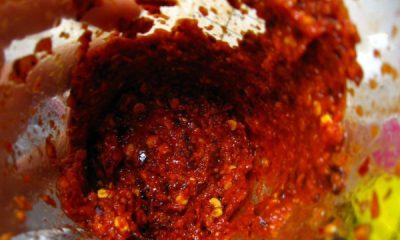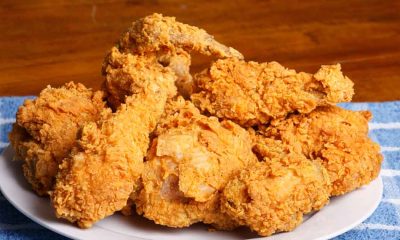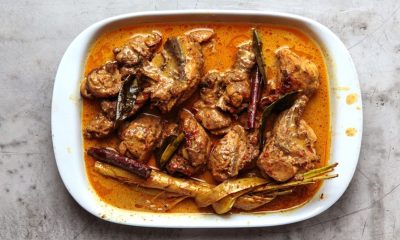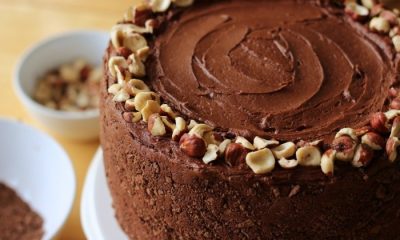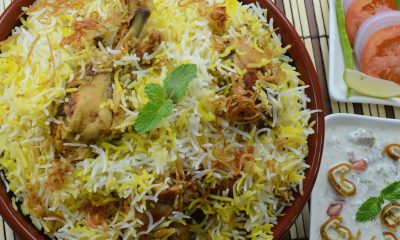Food Blogs
Poulet Roti Recipe
You can always judge the quality of a cook or a restaurant by roast chicken. While it does not require years of training to produce a juicy, brown, buttery, crisp-skinned, heavenly bird, it does entail such a greed for perfection that one is under compulsion to hover over the bird, listen to it, above all see that it is continually basted, and that it is done just to the proper turn. Spit roasting, where the chicken is wrapped in fat and continually rotated, is far less exacting than oven roasting where you must constantly turn and baste.
Small French chickens are frequently roasted without a stuffing. The cavity is seasoned with salt and butter, and the skin rubbed with butter. For oven roasting, it is browned lightly for 10 to 15 minutes at a temperature of 425 degrees, then the temperature is reduced to 350, and the chicken is turned and basted until it is done. A simple, short deglazing sauce is made with stock and the juices in the pan, giving just a scant spoonful for each serving.
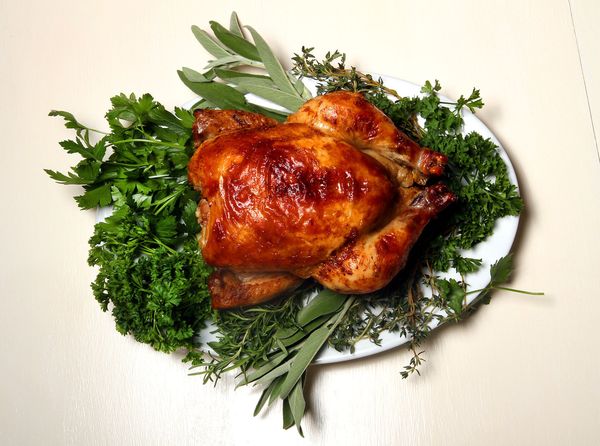
| Servings |
MetricUS Imperial
|
Ingredients
- A 3-lb. ready-to-cook roasting or frying chicken
- tsp ¼salt
- 2 Tb softened butter
- A shallow roasting pan just large enough to hold the chicken easily
- To flavor the sauce: a small sliced carrot and onion
- For basting: a small saucepan containing 2 Tb melted butter 1 Tb good cooking oil; a basting brush
- tsp ¼salt
- tsp ¼salt
- ½ Tb minced shallot or green onion
- 1 cup brown chicken stock canned chicken broth, or beef bouillon
- salt and pepper
- 1 to 2 Tb softened butter
Ingredients
|

|
Instructions
- Estimated roasting time for a 3-pound chicken: 1 hour and 10 to 20 minutes
- Preheat oven to 425 degrees.
- Sprinkle the inside of the chicken with the salt, and smear in half the butter. Truss the chicken. Dry it thoroughly, and rub the skin with the rest of the butter.
- Place the chicken breast up in the roasting pan. Strew the vegetables around it, and set it on a rack in the middle of the preheated oven. Allow the chicken to brown lightly for 15 minutes, turning it on the left side after 5 minutes, on the right side for the last 5 minutes, and basting it with the butter and oil after each turn. Baste rapidly, so oven does not cool off. Reduce oven to 350 degrees. Leave the chicken on its side, and baste every 8 to 10 minutes, using the fat in the roasting pan when the butter and oil are exhausted. Regulate oven heat so chicken is making cooking noises, but fat is not burning.
- Halfway through estimated roasting time, salt the chicken and turn it on its other side. Continue basting.
- Fifteen minutes before end of estimated roasting time, salt again and turn the chicken breast up. Continue basting.
- Indications that the chicken is almost done are: a sudden rain of splutters in the oven, a swelling of the breast and slight puff of the skin, the drumstick is tender when pressed and can be moved in its socket. To check further, prick the thickest part of the drumstick with a fork. Its juices should run clear yellow. As a final check, lift the chicken and drain the juices from its vent. If the last drops are clear yellow, the chicken is definitely done. If not, roast another 5 minutes, and test again.
- When done, discard trussing strings and set the chicken on a hot platter. It should sit at room temperature for 5 to 10 minutes before being carved, so its juices will retreat back into the tissues.
- Remove all but two tablespoons of fat from the pan. Stir in the minced shallot or onion and cook slowly for 1 minute. Add the stock and boil rapidly over high heat, scraping up coagulated roasting juices with a wooden spoon and letting liquid reduce to about ½ cup. Season with salt and pepper. Off heat and just before serving, swirl in the enrichment butter by bits until it has been absorbed. Pour a spoonful of the sauce over the chicken, and send the rest to the table in a sauceboat.
Recipe Notes
Roast chicken can wait for 20 to 30 minutes in the turned-off hot oven, its door ajar. It cannot be reheated or it loses its fresh and juicy quality.

